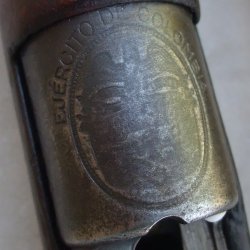Many recv'r markings can be re-cut by hand by an engraver. Not all engravers are willing to do this type of work (restoration). It's tedious and exacting work to make hand cut lettering and figure work end up looking like stamping/roll imprinted markings.
I used to do quite a lot of that sort of work as I did the restoration work and recut a lot of lettering damaged by buffing, drilled holes, doetailes cutting thru the lettering, etc.
It entails filling the holes and cuts first of course and those fillers must not show either.
I never used welding, just a cold, swaged steel plug. Of the right steel and done correctly it won't show and will not loosen.
Here's a rifle I've shown before, a 1950 Mann/Schoenauer with 9 D&T holes in it from 2 different scope mt attempts.
One was a side mount placed into the provided area on the left side of the recv'r, but they mounted it crooked.
The other a Leopold mt IIRC that D&T'd right thru the front ring and the lettering there as well as the left side wall of the recv'r and the lettering there as well. They broke a drill off in one of those holes as well.
All the holes were cleared and plugged using my method. Then taken down to the orig surfaces cleanly.
The orig lettering was then retraced/redrawn in simple pencil to pick it back up with the surrounding lettering.
Then hand cut the lettering that was damaged and missing back in with chisel to match the original look.
On the hidden sideplate surface, there was orig a filler plate installed when the rifle was made held with the one center screw. The owner removes the filler plate and installs the scope mount and D&T's the flat surface as needed.
The 'As Needed' didn't go too well for someone as they got the mount crooked. Plus they drilled straight through into the feed area of the recv'r when they did this (and the side wall screws as well).
All of these were plugged and finished off flush on the outside AND the inside as well.
Since the factory supplied steel filler dummy side plate was missing, someone filled the cavity for it on the LH side with brown epoxy. Remanants of the goo can be seen in one of the pics after early disassembly.
After digging that out and cleaning up the stock cut, I fitted a piece of matching wood to the cut. It's in place securely but not so much that it can't be cleanly removed if someone in the future might want to place a proper M/S side mount in there.
The wood filler can be seen in one of the last pics fitted betw the small dovetail edges on the LH side of the recv'r that orig held the steel dummy plate in place.
When done, the entire bbl, recv'r and parts were given a polishing to straighten out the slight rounding of edges an old refinish had done to it. I recut lettering on the floor plate, even the proof marks.
A Cold Rust Blue job finished it up. Customer was very happy.
Saved a nice rifle.
2 other Restoration Shops had the rifle prior to myself.
The first, a very well know entity, refused to do any work on it saying they don't work on Chevys, theirs is a Cadillac restoration business.
The other said they would put plug screws in the holes and that was it.
It shows what can be done, I've done likely hundreds of such jobs small and large on commercial and military pieces over the 50yrs of work.
Retired now, no more FFL, so I'm out of the biz.
Simple lettering is the easiest of course.
Recutting the very complex Crests seen on some Military rifles like the contract Mausers is more difficult especially as many have been very badly drawn out by buffing or are pitted and will leave nearly nothing to work with once cleaned up.





























